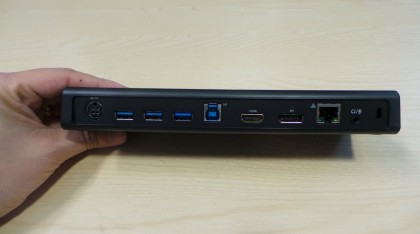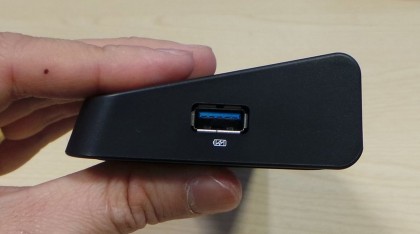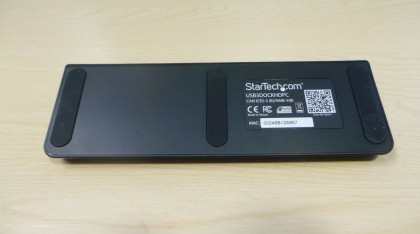TechRadar Verdict
This docking station provides 4K support, plus it allows the user to connect an array of devices and peripherals to it (as well as charging them). There are a couple of small issues but nothing major enough to distract us from the great value of this peripheral.
Pros
- +
True 4K capability
- +
Relatively affordable
- +
4 x USB ports
- +
True plug and play
Cons
- -
Can't charge your laptop
Why you can trust TechRadar
With 4K monitors becoming more widely available and with prices falling below £300/$300, one would have expected laptop manufacturers to smarten up and produce 4K friendly products. Well, it seems that this didn't happen unless you run an Apple MacBook/MacBook Pro/MacBook Air.
Some flagship products like the Lenovo Yoga 3 Pro still do not carry a mini-DisplayPort, opting instead for the more ubiquitous mini-HDMI connector. The latter, in its v1.4 iteration, is unfortunately not capable of running 4K.
Which is where the Startech USB 3.0 docking station (USB3DOCKHDPC) comes in and fills a niche. This is a great complementary accessory for Ultrabooks which usually have a couple of USB ports and no Ethernet connector (Apple's newest MacBook has just one port).
This product, which comes with a two-year warranty, is targeted mostly at Ultrabook users who will want to use their computers in the office remotely, and still be able to connect an array of devices to it in record time.
Design
Externally, this docking station is a slightly tapered, monolithic piece of plastic. Startech opted for that design because it can be tucked neatly under your laptop, but I saw it as an impractical solution, especially if you want to wire it up to half a dozen devices (which is certainly what I did).

It has plenty of ports to satisfy even the most demanding user: a GbE connector, DisplayPort, HDMI, four USB 3.0 ports (one of these on the side is a fast-charge, always-on model), an audio connector and a security lock. You won't be able to charge your laptop, though, as it is a universal model.
Using it was a treat – just connect the USB 3.0 cable provided to any USB 3.0 port on your laptop and let the device work its magic. I did, however, deliberately choose to install the latest version of DisplayLink, the essential piece of technology that allows the docking station to communicate with your monitor. Startech also provides you with drivers on a CD.
Sign up to the TechRadar Pro newsletter to get all the top news, opinion, features and guidance your business needs to succeed!
The kit, which uses the DL5900 chipset, is also compatible with various flavours of Windows (both 32-bit and 64-bit), and Mac OS X (from 10.6 onwards), though not officially with Linux. We haven't tried Windows 10 as well but there's no reason it shouldn't work.

Features
As for the dock's advertised 4K capabilities, I have to say that it worked perfectly well in an office environment (I didn't try games or graphically demanding applications like Maya). If your laptop doesn't support 4K natively, the dock will be able to offer 4K capabilities – you will still be able to use your laptop display as a second screen.
Alternatively if you don't have a 4K monitor to hand, you can always use the HDMI and the DisplayPort in tandem to output to two full HD capable displays.
Another possible setup is using it with a MacBook Pro to power two 4K monitors in addition to the Retina Display of that laptop, giving you access to more than 23 megapixels (or about two 5K monitors). Note that Startech sells a (much more expensive) Thunderbolt 2 4K docking station for your Apple product.
There is a big, big caveat though – your laptop will need to be a powerful one to drive 4K content, possibly one with a dedicated graphics card. Even a Lenovo Yoga 3 Pro with a Core M processor and an Intel HD 5300 GPU was not enough to provide a flicker-free environment.

Switching to a more powerful computer (we used a gaming laptop with a dedicated graphics card) was the solution. Speaking of gaming, this solution is likely to be inadequate for multi-screen, hard-core laptop-based gaming.
Not only does it add latency and would cause lag, the chipset used in the device is still a 30Hz model making the issue worse. On top of that, USB uses processor resources which can have an impact on performance; better stick to a DisplayPort connector if you have one.
Another issue we noted was the fact that the USB 3.0 transfer rate on any of the ports seemed to be throttled, which limits how quickly you can move a file to or from an external USB 3.0 storage device. This might be something to do with the fact that some capacity was earmarked/ring-fenced for display duties.

Désiré has been musing and writing about technology during a career spanning four decades. He dabbled in website builders and web hosting when DHTML and frames were in vogue and started narrating about the impact of technology on society just before the start of the Y2K hysteria at the turn of the last millennium.
